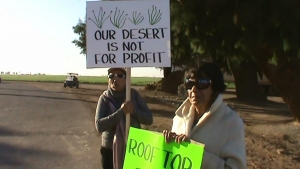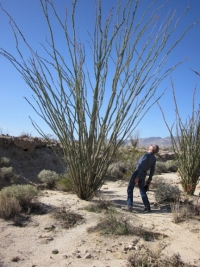 Story by Terry Weiner and Miriam Raftery
Story by Terry Weiner and Miriam Raftery
Videos by Jim Pelley
March 15, 2012 (Holtville)--Early Wednesday, rooftop solar activists and desert conservationists from Imperial Valley and San Diego County convened outside the Barbara Worth Resort—site of the Imperial Valley Economic Development Corporation's three-day Renewable Energy Summit and Expo.
Protesters oppose tax credits going to giant energy companies and called for similar incentives to help property owners put solar on their roofs. They also objected to their viewpoint being excluded by conference coordinators. Participants voiced concerns over negative impacts of industrial-scale wind and solar projects. In some cases, wind turbines have been abandoned, left as rusting blights on the landscape. Other concerns include destruction of habitat for wildlife, noise, health impacts, loss of agricultural lands, and destruction of recreational areas on public lands.
The Imperial Valley Economic Development Council, sponsor of the conference, did not return calls from ECM asking why advocates of rooftop solar instead of industrial-scale projects were not included on the conference agenda.
The citizens traveled from Holtville Calexico, Winterhaven, Ocotillo, and San Diego County, armed with large posters and hand-drawn signs. They expressed incredulity and dismay that the topic of rooftop solar and distributed generation was entirely missing from this conference on renewable energy. The conference organizers had confirmed that the summit and expo would focus exclusively on remote large-scale solar and wind projects on Imperial County desert public lands and farmland. The coalition decided to take this opportunity to bring awareness of the missing rooftop solar alternative to the public and media via a demonstration and signage.
 Susan Massey said she is upset to see the federal government providing “over $200 million” in subsidies to a wind project developer. “Their plan is to put up 112 40-story wind turbines around Ocotillo. They’re so close to where people are living, it’s definitely going to hurt their health and their sleep,” she said. "They’re taking 20 square miles of federal land, that means our land, the most beautiful desert in the whole county…This is the richest desert vegetation and they’re tearing it up…They’re using our tax dollars and it’s going to be their profits.”
Susan Massey said she is upset to see the federal government providing “over $200 million” in subsidies to a wind project developer. “Their plan is to put up 112 40-story wind turbines around Ocotillo. They’re so close to where people are living, it’s definitely going to hurt their health and their sleep,” she said. "They’re taking 20 square miles of federal land, that means our land, the most beautiful desert in the whole county…This is the richest desert vegetation and they’re tearing it up…They’re using our tax dollars and it’s going to be their profits.”
She believes subsidizing homeowners and business owners to put rooftop solar on homes, businesses and parking lots would be a much quicker way to get renewable energy online. View her full statement: http://www.youtube.com/watch?v=dMjZk2bjsBc&feature=youtu.be
 Anita Nicklen of El Centro observed, “We know that there are 14,000 wind turbines abandoned in the U.S. and some are in the beautiful islands of Hawaii. They’re not removing them.:(Read more about abandoned turbines here: http://hawaiifreepress.com/main/ArticlesMain/tabid/56/articleType/ArticleView/articleId/1698/Wind-Energys-Ghosts.aspx )
Anita Nicklen of El Centro observed, “We know that there are 14,000 wind turbines abandoned in the U.S. and some are in the beautiful islands of Hawaii. They’re not removing them.:(Read more about abandoned turbines here: http://hawaiifreepress.com/main/ArticlesMain/tabid/56/articleType/ArticleView/articleId/1698/Wind-Energys-Ghosts.aspx )
Nicklen believes solar rooftop is more cost effective and that if adopted on a wide scale, “eventually the cost of our electricity is going to go down and benefit low income families here in Imperial County and also the whole USA.”
She also voiced concern that destroying the desert’s top layer would exacerbate respiratory problems. “More than 20% of our children here in Imperial County suffer from asthma,” she said, adding residents also fear the spread of Valley Fever, a potentially deadly disease with spores that rest in the soil.
As for the wind industry subsidies, she observed, “With that money, we can subsidize so many people here in Imperial County and around the country. It doesn’t make any sense.”
View her full statements: http://youtu.be/2tjOgs7KUP4
http://www.youtube.com/watch?v=nzCVYF3qriw&feature=youtu.be
The group created a stir with the Barbara Worth security guards who, upon noticing the gathering, began buzzing around in their golf carts. Protesters were careful, however, to remain off the property and along the shoulder of the public road leading to the resort.
Loss of agricultural lands to the growing number of solar and wind projects is another key concern. Some fear that as with ethanol production which drove up corn prices, so too could energy production on former crop lands drive up food costs.
 People with protest signs lined up along Country Club Road, on one side of which are modest houses and on the other side, a densely planted field of ripe broccoli. Shortly after the group convened, farm workers arrived and began to move through the broccoli field, hand-picking the broccoli while other workers sorted and boxed it.
People with protest signs lined up along Country Club Road, on one side of which are modest houses and on the other side, a densely planted field of ripe broccoli. Shortly after the group convened, farm workers arrived and began to move through the broccoli field, hand-picking the broccoli while other workers sorted and boxed it.
Soon, Imperial County sheriff deputies appeared on the scene in two separate vehicles. They appraised the situation, talked to Barbara Worth security guards and to the foreman on the broccoli field and finally announced to the protestors that they had a right to exercise their free speech but to please avoid the tractor traffic and stay on the shoulder of the road. "Be safe," they advised.
One of the conference participants, a man from Germany who said he was a developer of large solar projects, eyed the group as he went by on his morning jog and on his way back shared his opinion about the drawbacks of rooftop solar and the superiority of industrial-size projects in remote desert. A lively discussion ensued about the value of undeveloped public land, Germany's lack thereof, and German citizens’ enthusiastic embracing of rooftop photovoltaic solar and about the need to shift U.S. policy incentives toward the German model.
Terry Weiner, Imperial County Coordinator for the Desert Protective Council and a co-founder of Solar Done Right, mused about the juxtaposition of activity occurring in the clear, crisp spring morning: the field workers energetically and efficiently conducting their harvest, destined to nourish people in all parts of the USA, alongside a parade of suited, serious-looking men and women, many in super-sized SUVs with the windows closed, destined for two days of sitting in windowless conference rooms strategizing about how to profit from converting functioning desert ecosystems and productive farm land to industrial energy zones.
In between these two incongruous activities, the citizens holding hand-crafted signs urged the protection of the desert and farmlands and encouraged people to consider an alternative that could save both as well as create abundant local jobs, cut down on greenh ouse gas emissions and reduce or eliminate home and business owners' electric bills.
ouse gas emissions and reduce or eliminate home and business owners' electric bills.
A number of demonstrators were from the small rural town of Ocotillo in Western Imperial County, where a massive wind turbine project on 12,000 acres of public land is proposed to the north, south and west of their small rural residential community. They expressed their love of the desert and desire for dark skies, peace and quiet as their reasons for moving to Ocotillo, as well as the trauma of facing threatened destruction of their cherished lifestyle by a 20- year industrial project that would destroy 20 square miles of desert.
San Diego residents joining the protest shared their own concerns over an industrial wind turbine project approved by the federal government for McCain Valley, a national recreation area owned by the Bureau of Land Management. The site is situated in prime golden eagle nesting areas and turbines will line the only road leading to scenic Carrizo Gorge and the Sawtooth Wilderness area, also surrounding both campgrounds in McCain Valley, where 120 turbines each over 450 tall are slated to go in unless the County bars access to the federal government, which already approved the project.
Yet a third wind project in the region is slated for the Sierra Juarez Mountains in Mexico, where 52 turbines are planned.
A key concern in all three areas is safety in the event of an earthquake. “I don’t think that the 400 to 500 foot tall wind turbines have ever undergone seismic testing,” Donna Tisdale, chair of the Boulevard Planning Group, has previously told ECM.
According to the U.S. Geological Survey, Seeley, California (located 17.8  miles from Ocotillo) has a staggering 86% chance of a quake measuring 6.0 or higher striking within 31 miles in the next 50 years, and nearly a 23% chance of a mammoth quake measuring 7.0 or higher. The region is considered the most seismically active in the U.S. and shares the same fault line that caused the devastating 7.2. Mexico earthquake that struck on Easter Sunday, 2010.
miles from Ocotillo) has a staggering 86% chance of a quake measuring 6.0 or higher striking within 31 miles in the next 50 years, and nearly a 23% chance of a mammoth quake measuring 7.0 or higher. The region is considered the most seismically active in the U.S. and shares the same fault line that caused the devastating 7.2. Mexico earthquake that struck on Easter Sunday, 2010.
The risk of a major temblor is also high in East County's McCain Valley. According to the USGS, there is a 36% chance of a quake measuring 6.0 or larger within 31 miles of Jacumba (adjacent to McCain Valley) and a 9% chance of a 7.0 quake or stronger. The prospect of giant turbines falling to earth in a quake could pose safety hazards for hikers and wildlife, as well as pose fire risks.










Recent comments